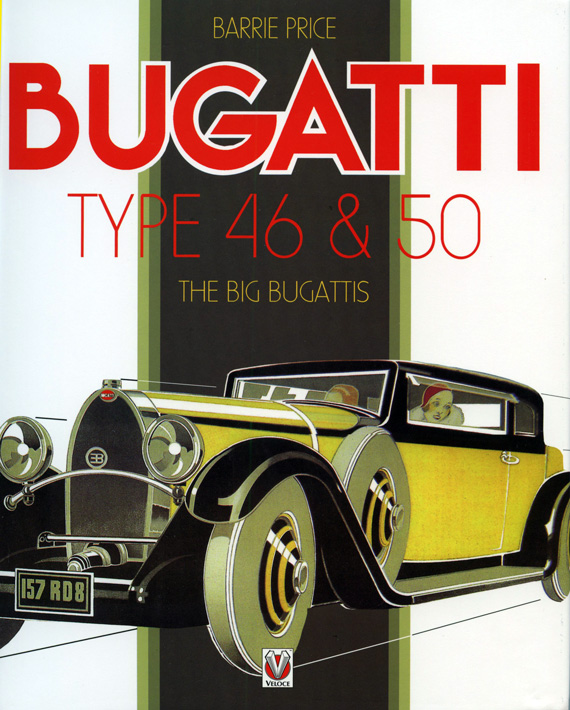 Bugatti Type 46 & 50 – The Big Bugattis
Bugatti Type 46 & 50 – The Big Bugattis
A Veloce classic, reprinted after several years absence!
By Barrie Price
25×20.7cm • 144 pages Over 200 B&W photos
ISBN: 978-1-845848-72-9
£ 37.50 $60.00 USA
Veloce Publishing, October 2015
Telephone – +44 (0)1305 260068
Facsimile – +44 (0)1305 250479
E-mail – info@veloce.co.uk
Review by Pete Vack
All black and white photos from the book
When embarking upon a discussion of Bugattis, even as a book review, one treads carefully. We are not as well informed as many Bugatti enthusiasts and we do not pretend to be experts. It is a remarkably complex field; between the introduction of the T35 in 1924 to the onset of WWII, Bugatti’s tiny factory produced 41 different automobile models, and within that 24 distinct types, with displacements ranging from 1.5 liters to 12.8 liters with four, eight and sixteen cylinders. Not only that, many models overlapped, with production inclusive of several models at the same time.
In addition and relevant here, there are remarkably few books about Bugatti, in particular specific Bugatti models. This makes fact checking difficult.
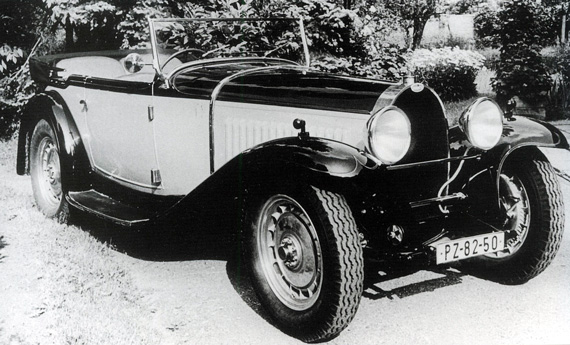
A very attractive convertible T 50, S/N 50128, by Sodomka of Prague. A wide variety of firms constructed bodies on the 462 T46 and 46S Bugattis..
A few years ago, Bugatti historian Barrie Price embarked upon a series of books that focused on one basic model; however even that was a combination of several. Still, it helped to narrow down the wide range of Bugattis and in some depth illustrated the individual type. Of the first was Bugatti Type 46 & 50, The Big Bugatti, reviewed below. Then came Bugatti 57 – The Last French Bugatti along with The Bugatti Type 40, followed by Bugatti The 8-Cylinder Touring Cars 1920-1934: Styles 28, 30, 38, 38a, 44 & 49 in 2007. We have just received Veloce Publishing’s reprint of the Type 46 & 50 as well as the longer more comprehensive Type 57 book (reviewed separately).
Often overshadowed by the illustrious Type 57 and the humongous Type 41 Royale, the Type 46 was built in large numbers, at least for Bugatti. The primary difference between the 462 SOHC Type 46 constructed and the 65 Type 50s built was the use of the DOHC head (fixed). Introduced at the onset of the Great Depression, the success was limited but despite that and the high prices, the Type 46 and 50 sold well enough until the end of their runs in 1934.
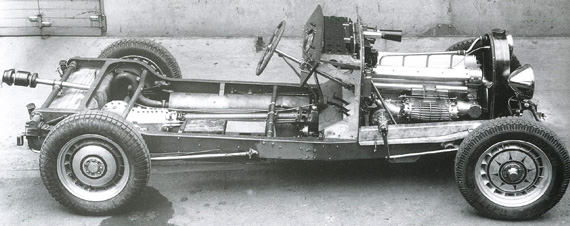
Thought be the first T50. Note the rear differential combined with the three speed transmission but no independent suspension, and the straight eight DOHC 4.9 liter engine. The luxury supercar of its era.
What is unusual is that the rear transaxle did not feature independent suspension; the increased unsprung weight was noted, but not mentioned in the book is the means by which the obviously flexible unit was supported by the frame (or was it?); the rear springs were quarter elliptics but that is not discussed either. The clutch was a dry multiplate affair mounted in rubber-isolated flywheel off the crankshaft which was enough to explain in some detail but also missing.
The Type 46 is one of the most technically interesting of all the Bugattis. However, an unfortunate lack of technical detail (perhaps it is taken for granted?) is the main criticism of the Price books; there are no complete specifications; there are few drawings; there are few photos of the rear end or suspension; the engine is described in some detail but is incomplete. A similar complaint can be lodged against the Type 57 book.
Saving grace were the many photos of the engine configuration. It was complex; to do a valve job (so common in those days) it was necessary to remove the engine; to remove the engine the rear transmission and differential had to be moved or removed; the entire engine had to be dismantled in order to get to the valves due to the fixed cylinder head on both the DOHC and SOHC blocks.
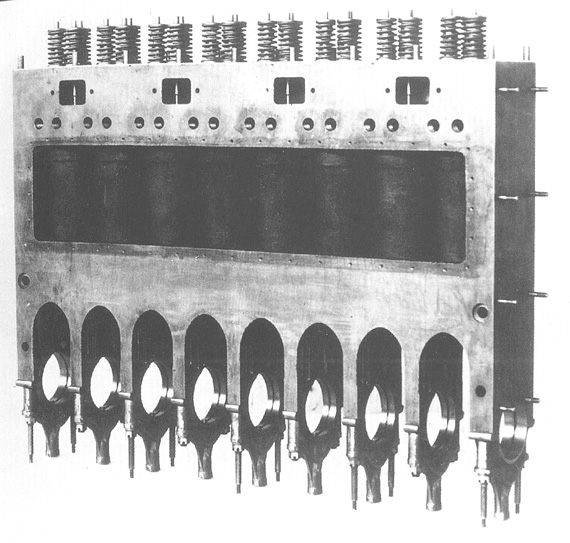
Cast iron block included nine main bearings. Bugatti, however, was not the first to cast such a block, crank bearing and head assembly.
The massive cast iron casting included the head all the way down to the crank bearing caps and was as rigid as it was hard to cast. Yet, seeing it all assembled, it all appeared to be an aluminum engine because most of the cast iron block was covered in aluminum plates and an entire aluminum box was created to serve as the sump: Impressively and artistically Bugatti.
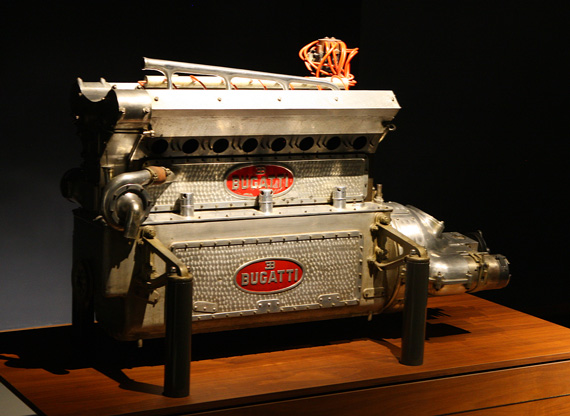
On his tour of the Schlumpf (read story)Jonathan Sharp photographed this T50 engine. Looks like it’s aluminum, but not.
Despite carping on the lack of detail, I still nevertheless enjoyed the Price book and would not be without it, for he has gathered a wonderful variety of photographs taken of all manners of the type in all the amazing displays of coachwork. Perhaps nowhere else can on see as many Type 46 and 50s in one tome; for that alone the book is worth the price and worth owning. Page after page it gives one a feeling of the depth of both Bugatti and the coachbuilders.
Most, surprisingly were either built or designed by the Bugatti staff and many of those were constructed by Gangloff, Bugatti’s local and favored coachbuilder. But Price, much to his credit (and why the book is a must have) takes pains to publish over 200 photos of the T46/50, including some rare coachbuilder’s efforts such as Gaston Grummer, James Young, Freestone and Webb, Van Vooren, Kellner, Lancefield, Graber and Sodomka (of Prague). The photos are not perfect and yet just the way we like them; historical, rare and enlightening.
During those years, Jean Bugatti was just getting into his stride as a designer, first with the fiacare style then, quickly and startlingly, with the Profilée coupes, (the semi a notchback and the full Profilée a rare fastback) a style that was shared with the Type 57 but really came into vogue on the T 50.
As sad as the Profilée was stunning was an attempt to use Cadillac parts for one effort which resulted in a confusion of ponderous curves.
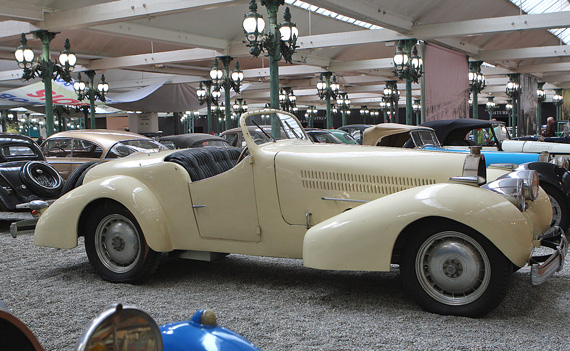
...while Sharp found the same car, still at the Schlumpf, now called the “Bugatti Torpedo Grand Sport.” Or so the placard said.
Also bear in mind that as this is the “Little” T41, it is big; a wheelbase of 11 foot 5 inches, a track of a bit over 4 ft and weight of 2500 lbs. for the chassis alone and 20 inch wheels.
Many of the standard cars were four door sedans, dour and stately, few really attractive. There was also an attempt to make a go of pillarless contruction ala the Lancia Appia, but one wonders how long that lasted.
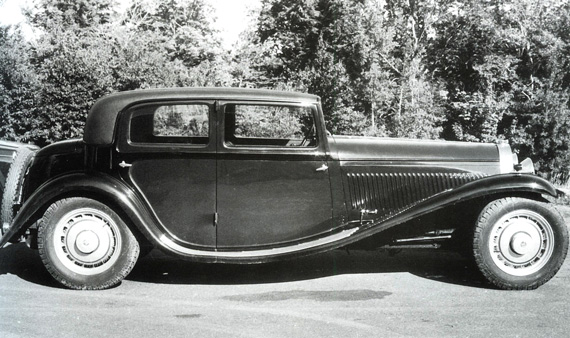
A nice four door by Freestone and Webb, an English coachbuilder effort from about 1931. Price captions this as S/N 46533; he identifies cars by serial number when possible.
Several attempts were made at Le Mans with the model, without much success, but a chapter is devoted to those cars.
Unfortunately without going into a great deal of detail, Price includes a chapter entitled “Anatomy of the Type 46 & 50 Bugattis”, consisting of photos of cars in a state of repair or restoration. Very handy but with few words to fully explain the fascinating photos.
Last but not least is a factory list of serial numbers of all Type 46 and 50 cars. At best this list includes the engine number (rare), the Agent, Invoice date, owner, style, coachbuilder and remarks. However, in all too many cases, nothing but serial number is available.
But if you like Bugattis and want to learn more about them, the books forged together by Barrie Price are not only essential but affordable; the Type 46 &50 is only $60. There is another book available now one the subject and comes highly recommended but very expensive; consider BUGATTI TYPE 46 LA PETITE ROYALE published in 2008 and still available for about 225 GPS or $320. We have yet to review it.
Below, courtesy the Bugatti Trust, are the specs of the Type 46 & 50.
Bugatti Type 46/46S
T46 = 444
T46S = 18
Dimensions
Wheelbase: 138 ins, 3.5m
Track: 55 ins, 1.4m
Chassis weight (approx): 2,500 lb, 1.150kg
Engine
No. of cylinders: 8
Bore x stroke: 81 x 130mm
Capacity: 5,359cc
BHP (approx): T46 140; T46S 160
RPM limit (prudent): 3,500
Camshafts (overhead): 1
Valves per cylinder: 3
Camshaft drive: Front, bevel
Crankshaft bearings (no. & type): 9 plain, plain rods
Supercharger: Roots, T46S only
Carburettor: 1 Smith multi-jet
Ignition: Coil
Plugs per cylinder: 2
Bugatti Type 50/50T
4.9-Litre Grand Sport
(T=Tourism Version)
Identifying Features:
Large size, alloy wheels (sometimes), 20in wheels
Years Made
(approx): 1930-34
Number Made:
65
Engine:
No of cylinders: 8
Bore x stroke: 86 x 107mm
Capacity: 4972cc
BHP (approx): T50: 225; T50T: 200
RPM Limit (prudent): 4000
Camshafts: dohc
Valves (per cylinder): 2
Camshaft drive: Front, spur train
Crankshaft bearings: 9 plain, plain rods
Supercharger: Roots, bevel driven
Carburettor: 2 Zenith 36 or Schebler
Ignition: Coil
Plugs per cylinder: 1
Firing Order: 1, 6, 2, 5, 8, 3, 7, 4
Clutch:
Type: Dry, multi-plate
Gearbox:
Location: In rear axle, 3-speed and reverse
Gear change lever: Central, ball type
Rear Axle:
Normal Ratio: 14/54 = 3.85
Dimensions:
Wheelbase: T50: 122in, T50T: 138in; (T50: 3.1, T50T: 3.5m)
Track: 55in (1.4m)
Chassis Weight (approx): 2600lb (1200kg)
Brakes:
Location and Type: 4-wheel, cable operated, auto adjuster.
Brake drum diameter: 16in
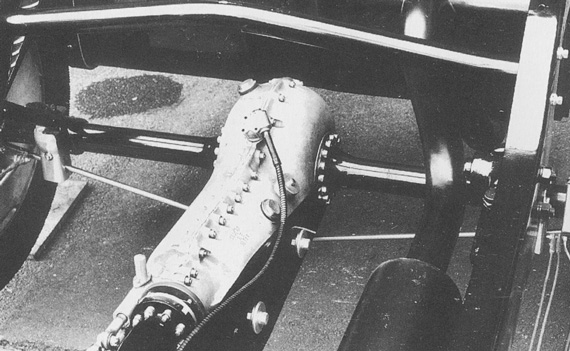
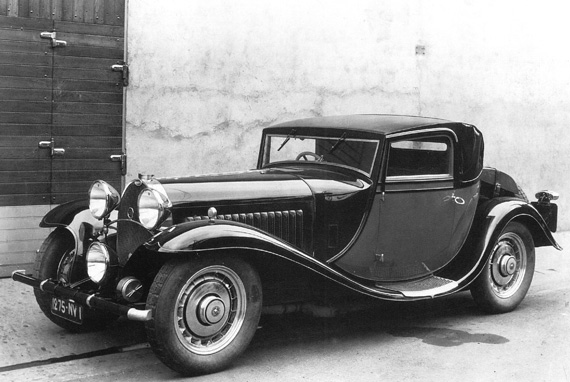
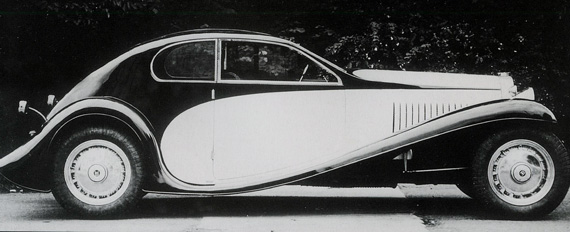
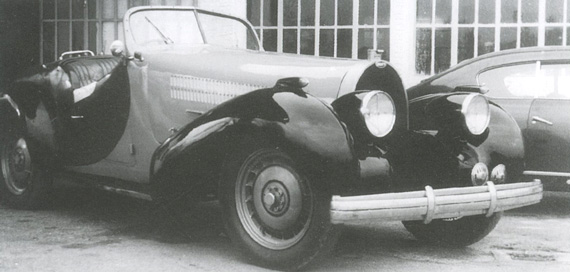
50 128 not body Sodomka, Body by Tomáš, Prague.
We’ll chalk that one up to a mistake in the book. [Ed.]
Back in 1963 in Aurora Colorado there was a type 57? in a garage that was completely disassembled . Don’t remember much else about it accept that the body was stripped and was on some kind of stand. The garage was on Colfax Ave. I think not too far into Aurora from Denver.I believe the garage was on the north side when heading east.
I think the road was Colfax , if not it was the main drag between Denver going into Aurora. I in was stationed at Lowry afb in Denver in 1963.
Wonderful photos, from périod !
The T46 #46287 with Cadillac wings has the same front wings than the Cadillac série 60 Fleetwood 1939, without the “hole” for spare Wheel.
You have one in a junkyard on BarnFinds site.
H
It is hard to understand the reasons for a non updated reprint of this book which is still available in vast numbers on ebay and abebooks and on the shelves of remaindering book stores..Like most books by Barrie Price it is one you buy for the pictures.Technical info is lacking as you pointed out and I for one would have liked more photos of cars under restoration.
Contrary to the 8 Cylinder Touring Car book Price has refrained from the use of French in captions which is a good thing because the French in that book has nothing to do with the English and vice versa.This brings me to another point of criticism :when oh when are English speaking authors going to enlist the help of native speakers when deciphering lists of owners and dealers?Many foreign (to you) names simply can’t be right in the chassis numbers list at the end of the book.
Finally,I am shocked by the statement few books have been written on Bugatti;I have over seventy in my library and there are still a few titles missing.
Fortunately there is Ian Preston’s contribution on what it is like to own and drive one of these cars.That in itself is worth the price of the book.
Keep up the good work,
Michel Van Peel
Prior to buying this title, which I ultimately did, I attempted to research the author by relying on your review which proved to be a colossal waste of time since you misspelled his name.
Must not have been such a waste of time then! Thank you for buying the book.